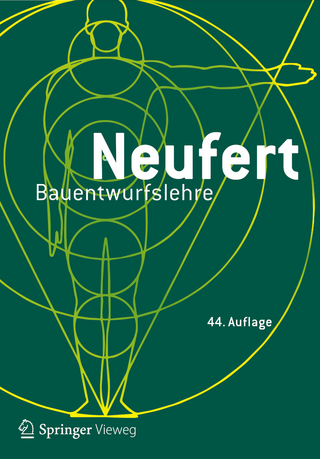
Fire Performance Analysis for Buildings
John Wiley & Sons Inc (Verlag)
978-1-118-65709-6 (ISBN)
A building fire is dynamic. A continually changing hostile fire environment influences time relationships that affect fire defenses and risks to people and building functions. The fire and fire defenses in each building interact with different sequences and distinct ways. Risks are characterized by the building’s performance.
Significantly updated and restructured new edition
Fire Performance Analysis for Buildings, 2nd Edition organizes the complex interactions into an analytical framework to evaluate any building - at any location - built under any regulatory jurisdiction or era. Systematic, logical procedures evaluate individual component behavior and integrate results to understand holistic performance. The Interactive Performance Information (IPI) chart structures complex time-related interactions among the fire, fire defenses, and associated risks. Quantification uses state-of-the-art deterministic methods of fire safety engineering and fire science. Managing uncertainty is specifically addressed.
Key features:
Emphasizes fire performance analysis for new or existing buildings.
Augments fire dynamics calculation methods with qualitative methods to form a more complete understanding of the effects of hostile fire characteristics on building performance.
Describes fire ground operations for engineers with no fire service experience. An analysis evaluates ways the site and building design help or hinder manual fire suppression.
Establishes a transition from traditional structural requirements to modern calculation based structural analysis and design for fire conditions. Structural concepts are described for non-structural engineers to enable the roles of each profession to be integrated into comprehensive performance evaluations.
Addresses techniques of managing uncertainty to improve understanding and communication with professionals of other disciplines.
Describes methods of risk management using information from the building’s performance analysis.
Fire Performance Analysis for Buildings, 2nd Edition has been completely restructured around a performance based framework. Applications integrate traditional fire defenses with fire science and engineering to combine component performance with holistic performance.
Robert W. Fitzgerald, Worcester Polytechnic Institute, USA Brian J. Meacham, Worcester Polytechnic Institute, USA
Preface xxiii
Acknowledgements xxv
1 Fire Performance and Buildings 1
1.1 The Dynamics of Building Fire Performance 1
1.2 The Anatomy of Building Fire Safety 1
Part I The Foundation 7
2 Preliminary Organization 9
2.1 Introduction 9
2.2 Overview of Evaluations 9
Part One: Organizational Concepts 12
2.3 The Diagnostic Fire 12
2.4 Anatomy of a Representative Fire 12
Part Two: Barriers, Spaces, and Connectivity 15
2.7 Spaces and Barriers 15
2.8 Barriers and Fire 15
Part Three: Fire Defenses 23
2.14 Fire Defenses 23
2.15 Active Fire Defenses 24
2.17 Closure 30
3 Tools of Analysis 31
3.1 Introduction 31
Part One: The Logic 32
3.2 The Framework Logic 32
3.3 The Major Parts 32
Part Two: Space–Barrier Connectivity 51
3.14 Introduction 51
3.15 Room Connectivity 51
Part Three: Additional Tools 55
3.19 Networks and Charts 55
3.20 Organizational Charts 55
4 An Introduction to the Interactive Performance Information Chart 59
4.1 Introduction 59
4.2 The Basic Template 59
5 Quantification 73
5.1 Performance Evaluations 73
5.2 Information Accessibility 74
Part II The Parts 79
6 The Room Fire 81
6.1 Introduction 81
Part One: Room Fire Concepts 82
6.2 Fire 82
6.3 The Role of Heat: Ignition 82
Part Two: Room Fire Descriptors 94
6.17 Introduction 94
6.18 Fuels 94
7 The Room Fire: Qualitative Analysis 119
7.1 The Role of Qualitative Analysis 119
7.2 Qualitative Estimates for Room Fires 120
Part One: Bottom‐up Estimates 121
7.3 Bottom‐up Scenario Estimates 121
7.3.1 Realm 1: FFS to IG 121
Part Two: Top‐down Estimates 133
7.7 Qualitative Room Classifications 133
7.8 FGP Comparisons 133
8 Beyond the Room of Origin 147
8.1 Introduction 147
8.2 The Inspection Plan 147
Part One: Barrier Effectiveness 149
8.3 Barrier Functions in Buildings 149
8.4 Barrier Fire Functions 149
Part Two: Barrier–Space Modules 159
8.8 Introduction 159
8.9 Barrier–Space Modules 159
Part Three: Qualitative Fire Analysis 165
8.17 Introduction 165
8.18 The Process 165
9 Smoke Analysis 175
9.1 Introduction 175
9.2 The Plan 176
10 The Diagnostic Fire 191
10.1 Diagnostic Fires 191
10.2 Interactive Performance Information (IPI) Chart and the Diagnostic Fire 191
10.3 Closure 192
11 Fire Detection 193
11.1 Introduction 193
Part One: Automatic Detection 194
11.2 Instrument Detection 194
11.3 Detection Instruments 194
Part Two: Human Detection 200
11.6 Concepts in Human Fire Detection 200
11.7 Human Detection Analysis 200
11.8 Closure 202
12 Alarm: Actions After Detection 203
12.1 Introduction 203
Part One: Alert Occupants 205
12.2 Focus on Alert 205
12.3 Alerting Occupants 205
Part Two: Notify Local Fire Department 209
12.5 Introduction 209
12.6 Human Notification (MN) 209
12.7 Discussion 212
12.8 Automated Notification Services 213
12.9 Discussion 216
Part Three: Building System Interfaces 217
12.10 Release Services 217
13 Fire Department Extinguishment: Arrival 219
13.1 Introduction 219
13.2 Organizing the Topic 219
Part One: Manual Extinguishment Overview 221
13.3 The Role of the Fire Department 221
13.4 Building Analysis Overview 221
13.5 Part A: Ignition to Notification 223
Part Two: Community Fire Departments 226
13.8 Fire Department Organizations 226
13.9 Fire Companies 226
Part Three: Community Fire Response 231
13.11 Fire Department Response Time 231
13.12 Communications Centers 231
14 Fire Department Extinguishment: First Water (MA) 237
The Fire Fighter and the Engineer 237
14.1 Introduction 239
Part One: An Overview of Manual Extinguishment Analysis 241
14.2 The Process 241
14.3 Phase 1: Initial Water Application (MA) 242
14.4 Summary 248
Part Two: A Brief Look at Fire Fighting 249
14.5 Initial Fire Ground Actions 249
14.6 Information 249
14.7 Pause for Discussion 251
14.8 Manual Fire Fighting 252
14.9 No Two Fires Are Alike 253
14.10 Summary 253
Part Three: Supply Water Analysis 254
14.11 Introduction 254
14.12 Scenario Analysis 254
14.13 Supply Water Analysis 258
Part Four: Interior Fire Attack Analysis 278
14.29 Introduction 278
14.30 Overview of Stretching Interior Attack Lines 278
14.31 Task Modules 279
Part Five: Phase 1 Analysis 290
14.39 Introduction 290
14.40 Phase 1 Comments 290
15 Fire Department Extinguishment: Control and Extinguishment 295
15.1 First Water Applied… Now What? 295
15.2 The Engineer and the Incident Commander 295
16 Automatic Sprinkler Suppression 305
16.1 Introduction 305
16.2 Sprinkler System Performance 305
Part One: Sprinkler Systems 307
16.3 Sprinkler Extinguishment 307
16.4 The Sprinkler System 308
16.5 Types of Sprinkler Systems 309
Part Two: Sprinkler Performance 312
16.6 Organization for Thinking 312
16.7 Agent Application (AA) 312
16.8 Agent Application Events 313
16.19 Automatic Suppression 323
16.20 Closure 324
17 The Composite Fire 325
17.1 Introduction 325
17.2 The Fire Limit (L) 325
18 Materials, Codes, Standards, Practices, and Performance 331
18.1 Introduction 331
Part One: Building Construction 333
18.2 The Structural Frame 333
18.3 Material Behavior in Fires 334
Part Two: Historical Perspective 338
18.4 The Built Environment Around World War I 338
18.5 Structural Practice Around World War I 338
Part Three: Fire Endurance Testing 345
18.12 Fire Test Interpretations 345
18.13 The Standard Fire Endurance Test 345
18.14 Fire Endurance Test Discussion 346
Part Four: Fire Severity 349
18.15 Introduction 349
18.16 Fuel Loads 349
18.17 The Ingberg Correlation 352
Part Five: Transitions 363
18.25 The Issue 363
19 Concepts in Structural Analysis for Fire Conditions 365
19.1 Introduction 365
19.2 Structural Fire Performance 365
Part One: Building Design 367
19.3 The Development Process 367
19.4 Building Design 367
19.5 Information Technology 368
Part Two: Structural Engineering and Building Design 371
19.6 The Master Builder 371
19.7 The Rise of Engineering 371
19.8 The Building 372
Part Three: Structural Engineering 377
19.13 Introduction 377
19.14 Beam Analysis 377
Part Four: Structural Analysis for Fire Conditions 387
19.18 Introduction 387
19.19 Outcomes 387
20 Target Spaces and Smoke 401
20.1 Introduction 401
20.2 Orientation 401
21 Life Safety 411
21.1 Introduction 411
21.2 Human Reaction to Products of Combustion 412
21.3 Tenability 414
21.4 Fire Fighter Safety 414
22 Risk Characterizations 417
22.1 Introduction 417
22.2 The Exposed 417
Part One: Human Safety 419
22.3 Life Safety 419
22.4 Overview of Life Safety Alternatives 419
Part Two: Other Risks 431
22.16 Property Protection 431
22.17 Continuity of Operations 431
23 Fire Prevention 435
23.1 Introduction 435
Part One: Prevent Established Burning 436
23.2 Prevent EB 436
23.2.1 Ignition Potential 436
23.2.2 Initial Fire Growth 437
Part Two: Automatic Special Hazard Suppression 442
23.7 Introduction 442
23.8 Carbon Dioxide Systems 443
Part III The Analysis 449
24 Fire Performance: Framework for Analysis 451
24.1 Organizational Concepts 451
24.2 Performance Evaluations 451
24.3 Analytical Framework 452
24.4 Fire, Risk, and Buildings 454
25 The Diagnostic Fire 455
25.1 Introduction 455
25.2 Top‐down Estimates 456
26 Fire Detection 463
26.1 Introduction 463
Part One: Automatic Detection 464
26.2 Detection Analysis 464
26.3 Detection Example 466
26.4 Detection Estimate 469
26.5 Detector Reliability 469
Part Two: Human Detection 471
26.6 Concepts in Human Detection Analysis 471
26.7 Human Detection Analysis 471
26.8 Closure 473
27 Fire Department Notification 475
27.1 Introduction 475
27.2 The Human Link in Notification 475
28 Fire Department Extinguishment 483
28.1 Introduction 483
28.2 Framework for Analysis 483
29 Automatic Sprinkler Suppression 501
29.1 Introduction 501
29.2 Agent Application (AA) 502
30 The Composite Fire 517
30.1 Introduction 517
30.2 Event Logic Description 517
31 Structural Performance 521
31.1 Introduction 521
31.2 Interactive Performance Information (IPI) Documentation 521
32 Target Space Smoke Analysis 525
32.1 Introduction 525
32.2 Success or Failure? 526
32.3 Target Room Performance Bounds 527
33 Life Safety Analysis 531
33.1 Introduction 531
33.2 The Exposed 531
34 Prevent Established Burning 541
34.1 Introduction 541
Part One: Established Burning Prevention 544
34.2 Ignition Potential 544
34.3 Established Burning Evaluation 544
Part Two: Special Hazards Protection 550
34.6 The Role of Special Hazards Suppression 550
34.7 Framework for Analysis 550
Part IV Managing Uncertainty 555
35 Understanding Uncertainty 557
35.1 Introduction 557
35.2 Window of Uncertainty 557
36 Visual Thinking 581
36.1 Introduction 581
36.2 A Case Study 581
37 Introduction to Risk Management 597
37.1 Introduction 597
Part One: The Process 598
37.2 Audience 598
37.3 Fire Safety Management 598
Part Two: Information Acquisition 604
37.8 Introduction 604
37.9 Understand the Problem 604
Part Three: Develop a Risk Management Program 608
37.13 Structure a Risk Management Program 608
37.14 Evaluate “Prevent EB” 608
38 Analytical Foundations 615
38.1 Historical Origins 615
Part One: Logic Diagrams and Networks 617
38.2 Event Trees 617
38.3 Fault and Success Trees 618
Part Two: Probability 628
38.12 Meanings of Probability 628
38.13 Fire Safety Applications 629
Part Three: The Role of Judgment 632
38.17 Introduction 632
38.18 Building Decisions 632
Appendix A Organizational Structure 637
A.1 The Organizational Framework 637
A.2 Basic Organization 637
A.3 The Composite Fire 637
A.4 The Diagnostic Fire (Ī) 639
A.5 Fire Department Manual Extinguishment 640
A.6 Detection 640
A.7 Notification 642
A.8 Notification to Arrival 643
A.9 Arrival to Extinguishment 645
A.10 Automatic Sprinkler System 646
A.11 Building Response: Structural Behavior 647
A.12 Building Response: Space Tenability 648
A.13 Risk Characterizations 648
A.14 Occupant Movement 650
A.15 Other Risks 651
A.16 Prevent Established Burning (EB): Occupant Extinguishment 651
A.17 Prevent EB: Special Hazards Protection 653
A.18 Closure 653
Appendix B Model Building 655
Description 655
Plans 655
Index 661
| Erscheinungsdatum | 22.04.2017 |
|---|---|
| Verlagsort | New York |
| Sprache | englisch |
| Maße | 178 x 252 mm |
| Gewicht | 1247 g |
| Themenwelt | Technik ► Architektur |
| Technik ► Bauwesen | |
| Technik ► Maschinenbau | |
| ISBN-10 | 1-118-65709-8 / 1118657098 |
| ISBN-13 | 978-1-118-65709-6 / 9781118657096 |
| Zustand | Neuware |
| Haben Sie eine Frage zum Produkt? |
aus dem Bereich


